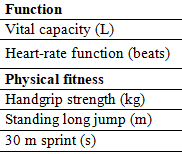Comparative Assessment of Morphological, Functional, and Fitness Profiles Among Vietnamese Undergraduates Relative to National MOET Standards
Keywords:
Anthropometry, Cardiorespiratory Function, Muscular Power, Agility, EnduranceAbstract
Background: Standardized fitness benchmarks by Vietnam’s Ministry of Education and Training (MOET) prescribe pass criteria across five domains—handgrip strength, standing long jump, 30 m sprint, 30 s sit-ups, and 5-minute run—for 18-year-olds. However, comparative data across academic disciplines are scarce. Purpose: To evaluate and compare morphological, functional, and physical fitness characteristics of first-year students at Ho Chi Minh City University of Technology (UTP) and University of Social Sciences and Humanities (USSH), and to determine compliance rates with MOET standards. Methods: Eighty-three UTP (59 M, 24 F) and 81 USSH (26 M, 55 F) students underwent anthropometry (height, weight, BMI), baseline cardiorespiratory assessments (vital capacity, resting heart rate), and fitness tests: handgrip strength, standing long jump, 30 m sprint, sit-ups/30 s, and 5-minute run. Results: Anthropometric and baseline cardiorespiratory profiles were similar across cohorts. UTP students exhibited marginally superior handgrip strength (male: 37.4 ± 6.4 kg vs. 34.1 ± 5.3 kg; female: 25.1 ± 4.4 kg vs. 23.7 ± 3.6 kg) and aerobic capacity (male: 889.2 ± 117.3 m vs. 720.2 ± 121.1 m; female: 782.3 ± 70.7 m vs. 630.6 ± 94.8 m). Universal pass rates were observed in standing long jump (>100 %) while 4×10 m shuttle runs yielded the lowest compliance (12.5 %–87.5 %). Overall MOET pass rates were higher in USSH (male: 96.2 %; female: 98.2 %) than in UTP (male: 66.1 %; female: 87.5 %). Conclusions: Despite comparable baseline profiles, UTP and USSH undergraduates display domain-specific strengths and deficits relative to MOET standards, notably in agility and endurance. These findings underscore the need for tailored physical education interventions to enhance student fitness.
Downloads
References
Bauer, N., Sperlich, B., Holmberg, H.-C., & Engel, F. A. (2022). Effects of high‐intensity interval training in school on physical performance and health of children and adolescents: A systematic review with meta‐analysis. Sports Medicine Open, 8, 50. https://doi.org/10.1186/s40798 022 00437 8
Costigan, S. A., Eather, N., Plotnikoff, R. C., Taaffe, D. R., & Lubans, D. R. (2020). High‐intensity interval training for improving health‐related fitness in adolescents: A systematic review and meta‐analysis. International Journal of Environmental Research and Public Health, 17(8), 2955. https://doi.org/10.3390/ijerph17082955
Costigan, S. A., Eather, N., Plotnikoff, R. C., et al. (2022). School‐based high‐intensity interval training programs in children and adolescents: A systematic review and meta‐analysis. PLoS ONE, 17(5), e0266427. https://doi.org/10.1371/journal.pone.0266427
Demetriou, Y., Margaritis, I., Kitta, A., et al. (2025). Impact of immersive virtual reality exercise on body composition and cardiovascular fitness: A case report. Journal of Functional Morphology and Kinesiology, 10(1), 56. https://doi.org/10.3390/2411 5142/10/1/56
Frontiers in Psychology Editorial. (2025). Associations between exercise motivation and cardiorespiratory fitness in young students. Frontiers in Psychology, 16, 1566952. https://doi.org/10.3389/fpsyg.2025.1566952
Huynh Thi Phuong Duyen, Hoang Ha. (2025). Physical and Physiological Assessment of Vietnamese University Students. Current Clinical and Medical Education, 3(6), 39–45. Retrieved from https://www.visionpublisher.info/index.php/ccme/article/view/249
Hoang, M. T., Tran, V. H., Vu, N. D., et al. (2024). Process evaluation of school‐based HIIT interventions and their effects on fitness and body composition: A systematic review. BMC Public Health, 24, 1786. https://doi.org/10.1186/s12889 024 17786 6
Lan, C., Liu, Y., & Wang, Y. (2021). Effects of different exercise programs on cardiorespiratory fitness and body composition in college students. Journal of Exercise Science & Fitness, 19(4), 297–304. Retrieved from https://www.researchgate.net/publication/357325557_Effects_of_different_exercise_programs_on_cardiorespiratory_fitness_and_body_composition_in_college_students
Ministry of Education and Training. (MOET) (2008). Decision No. 53/2008/QĐ BGDĐT on Promulgating Regulations for the Assessment and Classification of Physical Fitness of Students [Quyết định số 53/2008/QĐ BGDĐT về việc ban hành quy định về việc đánh giá, xếp loại thể lực học sinh, sinh viên]. Hà Nội, Vietnam: Author. Retrieved from https://vanbanphapluat.co/data/2008/09/67218_53 2008 qd bgddt.pdf
Nguyen, D. T., Penta, M., Questienne, C., et al. (2024). Normative values in healthy adults for the 6 minute and 2 minute walk tests in Belgium and Vietnam: Implications for clinical practice. Journal of Rehabilitation Medicine, 56, 18628. https://doi.org/10.2340/jrm.v56.18628
Sports Center, Vietnam National University Ho Chi Minh City. (2023). Summary report on physical education activities and student sports movement, period 2020–2023 [Báo cáo tổng kết hoạt động giáo dục thể chất và phong trào thể thao sinh viên giai đoạn 2020–2023]. Ho Chi Minh City, Vietnam: Author. Retrieved from https://www.tttdtt.edu.vn
Van Kieu, N. T., Jung, S. J., Shin, S. W., et al. (2020). The validity of the YMCA 3 minute step test for estimating maximal oxygen uptake in healthy Korean and Vietnamese adults. Journal of Lifestyle Medicine, 10(1), 21–29. https://doi.org/10.15280/jlm.2020.10.1.21
Wen, D., Utesch, T., Wu, J., Robertson, S., Liu, J., Hu, G., et al. (2020). Effects of different protocols of high‐intensity interval training for VO₂max improvements in adults: A meta‐analysis of randomised controlled trials. Journal of Science and Medicine in Sport, 23(7), 637–645. https://doi.org/10.1016/j.jsams.2019.01.013

Downloads
Published
How to Cite
Issue
Section
License

This work is licensed under a Creative Commons Attribution 4.0 International License.
Current Clinical and Medical Education













